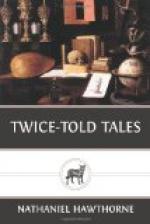This figure shall supply me with a moral wherewith, for lack of a more appropriate one, I may wind up my sketch. He fears not to tread the dreary path before him, because his lantern, which was kindled at the fireside of his home, will light him back to that same fireside again. And thus we, night-wanderers through a stormy and dismal world, if we bear the lamp of Faith enkindled at a celestial fire, it will surely lead us home to that heaven whence its radiance was borrowed.
ENDICOTT AND THE RED CROSS.
At noon of an autumnal day more than two centuries ago the English colors were displayed by the standard bearer of the Salem train-band, which had mustered for martial exercise under the orders of John Endicott. It was a period when the religious exiles were accustomed often to buckle on their armor and practise the handling of their weapons of war. Since the first settlement of New England its prospects had never been so dismal. The dissensions between Charles I. and his subjects were then, and for several years afterward, confined to the floor of Parliament. The measures of the king and ministry were rendered more tyrannically violent by an opposition which had not yet acquired sufficient confidence in its own strength to resist royal injustice with the sword. The bigoted and haughty primate Laud, archbishop of Canterbury, controlled the religious affairs of the realm, and was consequently invested with powers which might have wrought the utter ruin of the two Puritan colonies, Plymouth and Massachusetts. There is evidence on record that our forefathers perceived their danger, but were resolved that their infant country should not fall without a struggle, even beneath the giant strength of the king’s right arm.
Such was the aspect of the times when the folds of the English banner with the red cross in its field were flung out over a company of Puritans. Their leader, the famous Endicott, was a man of stern and resolute countenance, the effect of which was heightened by a grizzled beard that swept the upper portion of his breastplate. This piece of armor was so highly polished that the whole surrounding scene had its image in the glittering steel. The central object in the mirrored picture was an edifice of humble architecture with neither steeple nor bell to proclaim it—what, nevertheless, it was—the house of prayer. A token of the perils of the wilderness was seen in the grim head of a wolf which had just been slain within the precincts of the town, and, according to the regular mode of claiming the bounty, was nailed on the porch of the meeting-house. The blood was still plashing on the doorstep. There happened to be visible at the same noontide hour so many other characteristics of the times and manners of the Puritans that we must endeavor to represent them in a sketch, though far less vividly than they were reflected in the polished breastplate of John Endicott.




